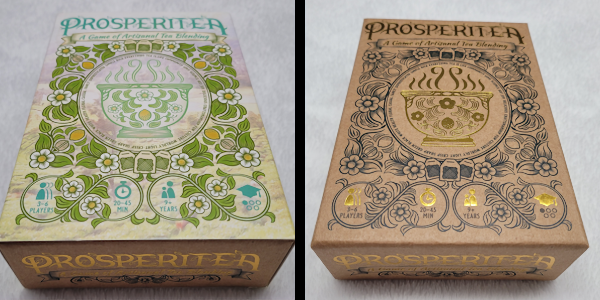Disclosure: Meeple Mountain received a free copy of this product in exchange for an honest, unbiased review. This review is not intended to be an endorsement.
The first thing you notice about this game is the gorgeous box. The colors are somewhat muted, but perfectly in theme. The box comes with a slip cover that keeps it closed. The inner box has a nice wood-grain tone with gold foil writing. Someone over at Mentha Designs loves this game and has taken some care to ensure that the presentation is welcoming and at the upper end of modern design.

The second thing you notice is that the components continue to deliver on the expectations the box created. The tokens are thick and beautiful, the ingredient cards have a nice finish and some very good artwork, and the order cards are cut to resemble tea bags – very thematic!

The last thing you notice is that nobody over at Mentha Designs put the same level of effort or care into the rules. The rulebook is missing information that you can only find on the reference card, and there are elements of the rulebook and reference card that are not in agreement.
Based on a few plays and attempting to put the two sources together into a cohesive whole, this is how I believe the game works.
Overview
The object of the game is to complete tea orders. Each order in the standard orders deck uses relatively common ingredients and can net you a few coins (to gather more ingredients) or a few points (moving you toward victory). Each order in the premium orders deck uses more and/or rarer ingredients and can net you more coins or more points than the standard orders. The player with the most points at the end wins.
There are four ingredient decks (Black tea, Green tea, Herbal Tisane, and Flavor). Shuffle each deck and place them in the center of the table.
There are two types of order cards (standard and premium). Shuffle each deck and place them in the center of the table. Deal out six standard orders to form the standard market; deal out three premium orders to form the premium market.
Randomly select a starting player. Each player gets an amount of starting money and a number of starting ingredient cards, based on player count and the order that the player will be playing. Generally speaking, players who start early get more money and fewer ingredients, while the opposite is true for players who start off later in the game. There does not appear to be any sort of adjustment for smaller or larger groups. When players gather their starting ingredients, they are able to blindly draw from any of the four ingredient decks. Ingredients are public knowledge. They are kept face up in your play area.
The setup is done and you are ready to play.

On your turn, you have two phases: sourcing ingredients and fulfilling orders.
Sourcing Ingredients: You may spend 0, 3, or 5 coins to draw 1, 3, or 4 ingredient cards. You must spend the money before you start drawing (meaning you have committed to your budget before you see what you get). If you do not want to source ingredients, you can instead do some marketing and just gain 2 coins instead.
Fulfilling Orders: After you have drawn cards in the sourcing phase, you can look at the ingredients you have and see if there are any orders in the market that you can fulfill. If there are, you can spend the ingredients and grab the order from the market. When you do, you can either collect money, or you can keep the order in your play area as points.
If you do not have the ingredients to fulfill an order (or do not want to spend that much), you can ask for the ingredients from the other players. You do not have to tell them what order you are fulfilling (but it is usually obvious). If they give you the ingredients and you fulfill the order, all of them are spent, the acting player gets the money or points, and the helping player(s) get a favor token which can be used in place of any ingredient on a future turn.
If you do not have the ingredients to fulfill an order (or do not want to spend that much), and you cannot get the help you need to do so, you can fulfill an evergreen order: a simple tea that is not represented on an order card (listed on the back of the reference cards) that will gain you a few coins to help you source more ingredients. If you do this, then you select an order card and discard it.
It is important to know that an order card is removed from the market every single turn. This is the game’s timer. Everytime an order is removed at the end of a player’s turn, it is immediately replaced from the appropriate deck. Once one of those decks is empty, the game is over.
Points are scored for order cards that were kept instead of gaining coins, plus one point for every unused favor token, plus one point for every five coins a player has at the end of the game.
Lumps
As indicated in the intro, the game—although it is quite simple—is not well documented in the rulebook. Several elements of the game are not described in the rulebook, but appear on the reference card (e.g., players apparently have a hand limit of seven cards). Several elements of the game use different terminology in the rulebook and the reference card (i.e., the rules call passing ‘advertising’ while the reference card calls it ‘marketing’). Several elements of the game are unclear because of how the rules and the reference card disagree (e.g., the rulebook suggests that you can pass the sourcing phase to get two coins while the reference card suggests that marketing is its own phase). It goes on and on. Really. And don’t get me started on the two-part first player token…
Even once you get past this and start playing, game design issues crop up. Ingredients have a rarity indicator (stars) used in calculating the payout for evergreen teas. The problem is that the rarities make no sense once you look at the ingredient decks. There is one ingredient that has special rules: nothing in the rulebook or reference card warned us about this. And so on.
Bitters
My group and I were able to figure out what (we think) the rules are supposed to be and play the game. The biggest issue is not the lack of clarity in the rules, but the fact that the game was not fun. It is a set collection game at heart but there is no moment of joy when the set is collected. The game was, well, boring. After we got through things and had an understanding of what we were doing, we all agreed there is the potential for a good game here. But it is not here yet.
This is a game that needed to steep just a bit longer.












Add Comment